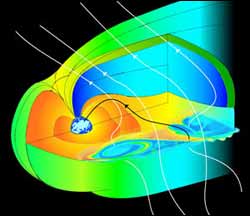
Since rain and freshwater flooding are the number one causes of death from hurricanes in the United States over the last 30 years, better understanding of these storms is vital for insuring public safety. A recent study funded by NASA and the National Science Foundation offers insight into patterns of rainfall from tropical storms and hurricanes around the world.
Researchers at the University of Miami’s Rosenstiel School of Marine and Atmospheric Science, Miami, and the National Oc
Professor John Raven of the School of Life Sciences at the University of Dundee has just been appointed chair of the Royal Society’s working group on ocean acidification. The task of the working group is to assess the available evidence on the extent of acidification in oceans and its impact on marine life.
The Royal Society, the UK’s academy of science is launching the working group and study because of concerns that the world’s oceans are becoming increasingly acidic, due to

A bevy of satellites buzzing around in the Earth’s magnetosphere has found at least part of the answer to a long-standing puzzle about the source of the charged particles that feed the aurora.
The charged particles come from explosions on the sun and smash into the Earth’s magnetic field, which repels the bulk of them. But many slip through, often via a physical process called magnetic reconnection, where the magnetic field traveling with the particles breaks and reconnect
Hospital patients increasingly face tenacious bacterial infections because microbes found in hospitals acquire resistance to commonly prescribed antibiotics. A recent strategy alternating the most commonly used antibiotics has sparked hope of stopping the spread of antibiotic resistance.
But a new model shows that the practice of cycling – alternating between two or more classes of antibiotics as often as every few months – probably will not work. It is an unexpected finding at a
For the second time in three years, a hypoxic “dead zone” has formed off the central Oregon Coast. It’s killing fish, crabs and other marine life and leading researchers to believe that a fundamental change may be taking place in ocean conditions in the northern Pacific Ocean.
The event appears similar to one in 2002, when an area of ocean water with low oxygen content formed in the nearshore Oregon coast between Newport and Florence, causing a massive die-off of fish and inver
NASA will extend operation of the Tropical Rainfall Measuring Mission (TRMM) through the end of 2004, in light of a recent request from the National Oceanic and Atmospheric Administration (NOAA). The extension, to be undertaken jointly with NASA’s TRMM partner, the Japan Aerospace Exploration Agency (JAXA), will provide data during another storm season in the U.S. and Asia.
TRMM has yielded significant scientific research data over the last seven years to users around the globe. In